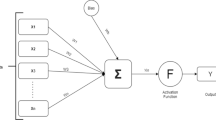Abstract
In this paper, we investigate the forecasting ability of the yield curve in terms of the U.S. real GDP cycle. More specifically, within a Machine Learning framework, we use data from a variety of short (treasury bills) and long term interest rates (bonds) for the period from 1976:Q3 to 2011:Q4 in conjunction with the real GDP for the same period, to create a model that can successfully forecast output fluctuations (inflation and output gaps) around its long-run trend. We focus our attention in correctly forecasting the instances of output gaps referred for the purposes of our analysis here as recessions. In this effort, we applied a Support Vector Machines technique for classification. The results show that we can achieve an overall forecasting accuracy of 66.7 and 100 % accuracy in forecasting recessions. These results are compared to the alternative standard logit and probit model, to provide further evidence about the significance of our original model.



Similar content being viewed by others

Notes
Imposing a weight parameter \(C\) for each erroneously classified data point in the minimization procedure.
References
Ang, A., & Piazzesi, M. (2003). A no-arbitrage vector autoregression of term structure dynamics with macroeconomic and latent variables. Journal of Monetary Economics, 50(4), 745–787.
Ang, A., Piazzesi, M., & Wei, M. (2006). What does the yield curve tell us about GDP? Journal of Economics, 131, 1–2.
Bordo, M. D., & Haubrich, J. G. (2008). Forecasting with the yield curve; level, slope, and output 1875–1997. Economic Letters, 99(1), 48–50.
Bernanke, B. S., Boivin, J., & Eliasz, P. (2005). Measuring the effects of monetary policy: a factor-augmented vector autoregressive (FAVAR) approach. Quart J Econ, 120, 387–422.
Calvao, A. B. (2006). Structural break threshold VARs for predicting US recessions using the spread. Journal of Applied Econometrics, 21, 463–487.
Chauvet, M., & Potter, S. (2002). Predicting a recession: Evidence from the yield curve in the presence of structural breaks. Economic Letters, 77(2), 245–253.
Christiansen, C. (2012). Predicting severe simultaneous recessions using yield spreads as leading indicators. Journal of International Money and Finance, 32, 1032–1043.
Chinn, M. D., & Kucko, K. J., (2010). The predictive power of the yield curve across countries and time. Working Paper 16398, NBER.
Chionis, D., Gogas, P., & Pragidis, I. (2009). Predicting European union recessions in the euro era: The yield curve as a forecasting tool of economic activity. International Advances in Economic Research, 16(1), 1–10.
Diebold, F., & Li, C. (2006). Forecasting the term structure of government bond yields. Journal of Economics, 130, 337–364.
Diebold, F. X., Rudebusch, G. D., & Aruoba, S. B. (2006). The macroeconomy and the yield curve: a dynamic latent factor approach. Journal of Econometrics, 131, 309–338.
Estrella, A. (2005). Why does the yield curve predict output and inflation. Economic Journal, 115, 722–744.
Estrella, A., & Hardouvelis, G. A. (1991). The term structure as a predictor of real economic activity. Journal of Finance, 46, 555–576.
Estrella, A., & Mishkin, F. S. (1997). The predictive power of the term structure of interest rates in Europe and the United States: Implications for the European Central Bank. European Economic Review, 41(7), 1375–1401.
Estrella, A., & Mishkin, F. S. (1996, June). The yield curve as a predictor of U.S recessions. Federal Reserve Bank of New York: Current Issues in Economic and Finance, 2(7), 1–6.
Estrella, A., & Trubin, M. R. (2006). The Yield Curve as a Leading Indicator: Some Practical Issues. Current Issues in Economics and Finance, Federal Reserve Bank of New York, 12(1), 1–7.
Gürkaynak, R. S., Sack, B., & Wright, J. H. (2007). The US treasury yield curve: 1961 to the present. Journal of Monetary Economics 54(8), 2291–2304.
Hodrick, R., & Prescott, E. P. (1997). Postwar business cycles: An empirical investigation. J Money Credit Bank, 29(1), 1–16.
Moench, E. (2008). Forecasting the yield curve in a data-rich environment: A no-arbitrage factor-augmented VAR approach. Journal of Econometrics, 146(1), 26–43.
Moneta, F. (2005). Does the yield spread predict recessions in the Euro area? International Finance, 8(2), 263–301.
Nyberg H (2010) Dynamic probit models and financial variables in recessions forecasting. Journal of Forecasting 29: 2115–230
Rudebusch, G. D., & Williams, J. C. (2009). Forecasting recessions: The puzzle of the enduring power of the yield curve. Journal of Business and Economics, Statistics, 27(4), 492–503.
Schrimpf, A., & Wang, Q. (2010). A reappraisal of the leading indicator properties of the yield curve under structural instability. International Journal of Forecasting, 26, 836–857.
Wright, J., (2006, February). The yield curve and predicting recessions. Finance and Economics Discussion Series, Federal Reserve Board 2006–7.
Acknowledgments
“This research has been co-financed by the European Union (European Social Fund—ESF) and Greek national funds through the Operational Program “Education and Lifelong Learning” of the National Strategic Reference Framework (NSRF)—Research Funding Program: THALES. Investing in knowledge society through the European Social Fund (MIS 380292).”
Author information
Authors and Affiliations
Corresponding author
Rights and permissions
About this article
Cite this article
Gogas, P., Papadimitriou, T., Matthaiou, M. et al. Yield Curve and Recession Forecasting in a Machine Learning Framework. Comput Econ 45, 635–645 (2015). https://doi.org/10.1007/s10614-014-9432-0
Accepted:
Published:
Issue Date:
DOI: https://doi.org/10.1007/s10614-014-9432-0



